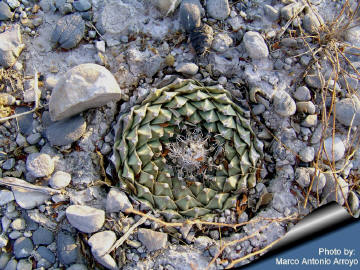|
|
|

This is one of the rarest and highly desirable of the
living rock cactus, very
characteristic and unmistakable. somewhat similar to
Ariocarpus, it
resembles an inverted green pine cone with a woolly centre.
|
|
 |

|
|
Two individuals (of the same size and age grown on 10 cm
Ř Pots) showing the variable morphology
of this species. The first (more typical) with broad large spaced
tubercles and the second with densely packaged tubercles and numerous
long yellow spines. |
|

A young specime (5 years old) |

Blooms |
|
. |
|
 |

(
Photo and © Copyright by Marco Antonio Arroyo - Mexico )
The habitat is relatively wet, plants generally grows in limestone,
among gravel and small stone in
the inferior part of a dense forest on lower hill slopes in
association with several other succulent
species |
|
. |
 |
 |
|
Propagation: Almost exclusively by seeds.
But the
seedlings are tiny and
very slow growing and
at first they take one or two years to
reach the diameter of 3-5 mm!!! Once they have reached 4 years old
or more they are relatively easy to grow, the problem
is getting them to 4 years old! Than they reach 5 cm of diameter in
about 5-6 years, and require very careful watering. Plants need
about 7-8 years to reach
the flowering size.
Seedlings are sometimes
grafted
onto column-shaped cacti to
increase their
growth
speed.
Grafting is a much easier way of propagation
than sowing. |
|
Advertising
|
|
|
|
|
|
|
Family:
Cactaceae (Cactus
Family)
Scientific Name: Obregonia denegrii
Frič,
In: Život v přírodě, 29(29: 14, 1925
Synonym:
-
Ariocarpus denegrii
(Fric) Marshall,
In: Cact. Succ. J. Amer. 18(4):56, 1946
-
Strombocactus
denegrii (Fric) Rowley
In Repert. P1. Succ. (lOS.) 23:9 (1972, publ. 1974
(without basionym date).
Vernacular name: Artichoke cactus
Conservation status: Listed in
CITES appendix I
Origin: Mexico (Tamaulipas: Ciudad Victoria)
Etymology: The genus is
named Obregonia to commemorate Alvaro Obregon (1880 - 1928) president of
Mexico.
NOTE: This
cactus is known as a "peyote" because it contained alkaloids similar to
those in the well known genus Lophophora. From this reason some authors
assume that the O. denegrii may be considered
a peyote species. Extracts of this cactus have been shown to have
antibiotic activity.
Habitat: Obregonia denegrii thrives both in open
areas and in dense bushes in the inferior part of a dense forest
on lower
hill slopes where
erosion is a serious problem.
Sometimes plant are washed out of the
ground by
rain.
The climate is relatively wet, plants
generally grows in limestone soil, among gravel and small stone in
association with several other succulent species like Agave
lechuguilla, Ariocarpus trigonus, and
Astrophtum myriostigma,
Mammillaria baumii, Neolloydia grandiflora, Coryphantha palmeri,
Echinocereus blanckii.
|
|
Description:
Obregonia is among the most famous of all cacti for is unique
artichoke-shaped stem. It is the only representative of its monospecific
genus and is related to Ariocarpus. It grows almost always as a solitary
plant levelled with the ground, with the sunk and woolly apex. It is
considered an intermediate form between Ariocarpus and Lophophora.
Stem:
Solitary, globular-squashed resembling an inverted pine cone with a
woolly centre, it grows up to 15 (or more) cm in diameter and is greyish
green to dark green.
Tubercles: Arising in a rosette, not imbricate, arranged in
a spiral, deeply cut like an artichoke, triangular,
prominent, leaf like, flat above, keeled below and with a basal ridge.
Areoles: Small at the tips
of the tubercles, with wool when young.
Spines: 2 to 4 whitish to brown about 5 to 15 mm long in the
young tubercles, ± soft flexible, slightly curved and often rapidly
shedding.
Roots: Thick
taproot.
Flower: The flowers grow between the wool of the apex, in the
centre of the stem on young tubercles, they are funnel-shaped white
diurnal, up to 2.5 cm in diameter, 2.5-3 cm long. External perianth
segments greyish, pericarpel naked or with few scales. Filaments reddish
purple or pink, anthers yellow, style white and stigma lobes white.
Blooming season: Summer.
Fruits: Hidden in the wool, pear-shaped, white naked, fleshy and
edible that dry when mature. The withered flowers remaining attached.
Seeds: Large and black 1 to 1.4 mm long.
|
|
|
|

(
Photo and © Copyright by Marco Antonio Arroyo - Mexico )
Photo in habitat
|
|

Old and large
specimens of this species are outstandingly beautiful.
Rosette of
leaf-like tubercles top this turnip-shaped cactus |
|
Cultivation:
This
slow growing plant isn't always the
easiest species to cultivate, but can enlarge relatively fast when well
grown.
It is often seen as a grafted plant but grows very well on its own
roots too. Needs a very well drained
mineral substratum with little organic matter (peat, humus).
Requires
light sun sun to
develop good compact growth and waterings should be rather
infrequent, to keep the plant flat shaped and not become excessively
elongated and unnatural in appearance. Use Water
sparingly from
March till October and keep perfectly dry in
winter, or when night temperatures remain below 10° C (but some
people give this plant a light monthly watering to prevent the
drying and shedding of the lower tubercles.) It is hardy to -4°C (or
less) for a short period. In the rest period no high
atmospheric humidity!!
Ensure
a
good
ventilation.

 |
|